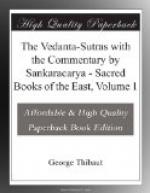Adhik. XXXIV (59) teaches that those meditations on Brahman for which the texts assign one and the same fruit are optional, there being no reason for their being cumulated.—Adhik. XXXV (60) decides that those meditations, on the other hand, which refer to special wishes may be cumulated or optionally employed according to choice.—Adhik. XXXVI (61-66) extends this conclusion to the meditations connected with constituent elements of action, such as the udgitha.
PADA IV.
Adhik. I (1-17) proves that the knowledge of Brahman is not kratvartha, i.e. subordinate to action, but independent.—Adhik. II (18-20) confirms this conclusion by showing that the state of the pravrajins is enjoined by the sacred law, and that for them vidya only is prescribed, not action.—Adhik. III (21, 22) decides that certain clauses forming part of vidyas are not mere stutis (arthavadas), but themselves enjoin the meditation.—The legends recorded in the Vedanta-texts are not to be used as subordinate members of acts, but have the purpose of glorifying—as arthavadas—the injunctions with which they are connected (Adhik. IV, 23, 24).—For all these reasons the urdhvaretasa/h/ require no actions but only knowledge (Adhik. V, 25).—Nevertheless the actions enjoined by Scripture, such as sacrifices, conduct of certain kinds, &c., are required as conducive to the rise of vidya in the mind (Adhik. VI, 26, 27).—Certain relaxations, allowed by Scripture, of the laws regarding food, are meant only for cases of extreme need (Adhik. VII, 28-3l).—The a/s/ramakarma/n/i are obligatory on him also who does not strive after mukti (Adhik. VIII, 32-35).—Those also who, owing to poverty and so on, are ana/s/rama have claims to vidya (Adhik. IX, 36-39).—An urdhvaretas cannot revoke his vow (Adhik. X, 40).—Expiation of the fall of an urdhvaretas (Adhik. XI, 41, 42).—Exclusion of the fallen urdhvaretas in certain cases (Adhik. XII, 43).—Those meditations, which are connected with subordinate members of the sacrifice, are the business of the priest, not of the yajamana (Adhik. XIII, 44-46).—B/ri/. Up. III, 5, 1 enjoins mauna as a third in addition to balya and pa/nd/itya (Adhik. XIV, 47-49).—By balya is to be understood a childlike innocent state of mind (Adhik. XV, 50).
Sutras 51 and 52 discuss, according to Ramanuja, the question when the vidya, which is the result of the means described in III, 4, arises. Sutra 51 treats of that vidya whose result is mere exaltation (abhyudaya), and states that ’it takes place in the present life, if there is not present an obstacle in the form of a prabalakarmantara (in which latter case the vidya arises later only), on account of Scripture declaring this (in various passages).’—Sutra 52, ’Thus there is also absence of a definite rule as to (the time of origination of) that knowledge whose fruit is release, it being averred concerning that one also that it is in the same condition (i.e. of sometimes having an obstacle, sometimes not).’—Sa@nkara, who treats the two Sutras as two adhikara/n/as, agrees as to the explanation of 51, while, putting a somewhat forced interpretation on 52, he makes it out to mean that a more or less is possible only in the case of the sagu/n/a-vidyas.




